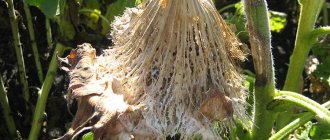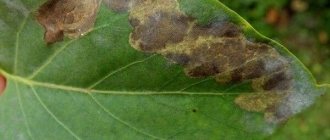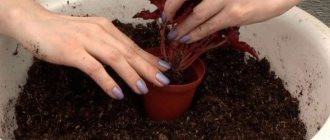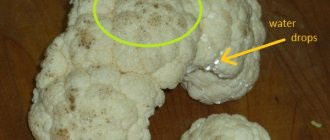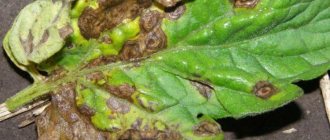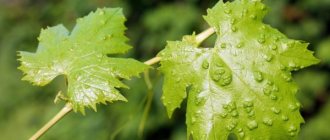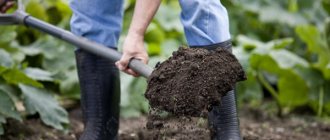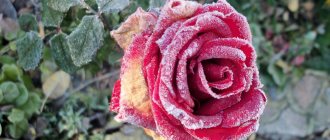Grapes are a crop that requires increased attention, especially if it is grown not in the south of Russia, but in the middle zone or Siberia. Since this plant is heat-loving, it is quite difficult for it to survive in a cool climate, and lack of proper care, unsuitable soil and various diseases can destroy not only the crop, but the entire plant, along with leaves, stems and roots.
Grapes, like most other living organisms, most often become infected through an infection that is transmitted from a diseased plant to a healthy one. Various viral diseases, fungi and harmful bacteria are transmitted in this way.
In many cases, disease carriers in vineyards are weeds and small earthen pests: insects and rodents.
For infected bushes, any external factor will affect their growth and development, be it soil fertility, its composition, air humidity, regularity of precipitation, etc. For example, during heavy rains, diseased grapes will simply rot.
There is also a non-infectious type of grape disease - these include various mechanical damage, such as improper pruning, sunburn of leaves, damage to roots by garden tools.
Introduction
Grapes are a difficult garden crop to grow.
This southern, heat-loving plant is extremely demanding on living conditions, therefore, even if agricultural standards are observed, it is susceptible to various infections. Timely detection and recognition of signs of infection and the use of adequate treatment methods will help to overcome them and save the harvest.
Bacterial diseases
Grapes are affected by 3 types of bacteria: saprophytic, rod-shaped and soil. Each of these groups includes about 100 species of bacteria. Almost all of them are carried by insects, birds and, less commonly, by humans.
Diseases develop rapidly and can completely deprive the gardener of not only the harvest, but also all grape plantings.
Bacteriosis of berries
The process starts during the formation of the ovary. The brush becomes partially infected. It is especially dangerous in hot weather when the clusters are located on the sunny side. Main features:
Small yellow spots on berries
Formation of brown-violet dents in place of spots
Drying of the pulp
As the pathology progresses, the berries dry out within 7 days. It is important to prevent the development of bacteriosis:
- protect fruiting plants from exposure to the sun;
- prevent mechanical damage.
- carry out phytoquarantine when purchasing new seedlings;
- carry out a number of measures to protect against pests that violate the integrity of the crop.
Bacterial necrosis (bacterial wilt, Oleuron's disease)
A disease that affects the entire above-ground part of the plant. Do the signs appear gradually?
Shoot growth slows down
Black spots form on leaves and branches
Kidneys become deformed
Knots become brittle
The buds turn black
To combat necrosis, use a 5% solution of Bordeaux mixture. No less effective are sulfur-based preparations at the initial stage of infection and repeated treatment with 2% Bordeaux solution when the leaves bloom.
Pierce's disease
The causative agent of this disease is the gram-negative rickettsia-like bacterium Xylella fastidiosa from the Gammap class; leaf drying, which begins from the edges, is observed.
Plant shoots grow slowly
Shoot internodes are short
With the onset of cold weather, branches and leaves begin to turn black
Drying leaves
Treatments for this disease have not yet been developed. Experts advise growing bacteria-resistant varieties.
Bacterial cancer
The causative agent of the disease is the bacterium Agrobacterium vitis. It is activated when the plant’s immunity decreases, especially when shoots freeze in winter. Signs of the disease:
Lack of ovaries
Drying edges of leaves
Deterioration in the taste of berries
Formation of tubercles on the shoots
The most dangerous symptom is tumors on the branches. They disrupt the processes of photosynthesis, so the bush completely stops development.
You can cope with the disease only in the early stages. The drugs Fitoplasmin and Fitoflavin are used for treatment.
Phytoplasmin
Phytoflavin
Mildew (downy mildew)
This disease is also caused by a fungal infection. The fungi overwinter in fallen leaves and begin to attack the vineyards in the spring. The best environment for it is high humidity. Externally, the disease can be diagnosed by yellowed leaves and a slightly oily coating. Over time, the sheet becomes deformed. With the onset of summer, a grayish cobwebby coating forms on the leaves.
To protect against the disease, preventive measures are taken:
- Avoid wet areas when planting vineyards;
- spring spraying with Bordeaux mixture or preparations “Ridomil”, “Antrakol”, “Horus” , “Bordeaux mixture” , “Kuproksat”, “Kuprostat”, “Strobi”, “Thanos”, “HOM”.
Preparing a solution of Bordeaux mixture
The simplest and most effective way to prevent diseases is to spray the vineyards in early spring before the buds open with a 3% solution of Bordeaux mixture . Let me remind you that a ready-made solution of Bordeaux mixture can be bought in garden stores, or you can prepare it yourself. For this purpose in 5l. water dissolve 300g. copper sulfate. In the second container of 5 liters. water dissolve 300g. slaked lime and then add the first composition.
Viral diseases
The danger of viral diseases of grapes is their incurability.
Experienced winegrowers are well aware that the only correct solution when infected with any virus is to uproot the bush. If this is not done, the disease will destroy all grape plantings in a short time.
Infection with the virus occurs when planting young seedlings or during an attack by insect pests. The symptoms of diseases are in many ways similar to fungal diseases, so gardeners often treat them with fungicides and allow the virus to penetrate plants adjacent to the infected bush.
Short knot (infectious degeneration)
The first symptoms of this infection appear when it becomes chronic. If the infestation is recent, heart-shaped or linear patterns will be visible on the leaves.
Heart-shaped or linear patterns
Oily stains that emit an unpleasant odor
Insects that additionally infect bushes with fungi and bacteria
Small and curly leaves
Then greasy spots appear, emitting an unpleasant odor. The sticky coating attracts insects, which additionally infect the bushes with fungi and bacteria. This situation causes accelerated death of the bush.
In later stages, the leaves lose their normal shape and become small and curly. The tips lengthen, and the distance between the veins decreases.
Expert opinion
Evgeniy Georgievich Pavlovsky
breeder who created a hybrid
All this is a consequence of damage to the root system. The plant cannot provide the aboveground part with enough nutrients. Ultimately, the crop suffers. Fruits continue to form on the inflorescences, but very small ones. They do not have time to ripen, so they begin to crumble.
The cause of the disease is planting in clay soil, lack of loosening, which provokes a lack of oxygen.
Necrosis of wood vessels
The virus invades the vessels of the vine and completely disrupts the nutritional processes. The bush gradually begins to rot. A sign of infection is whitening of the leaves. Completely deprived of nutrition, they stop the processes of photosynthesis.
The only way to slow the progress of the disease is to remove all affected parts of the bush. If the virus has spread to a significant part of the plant, the bush is uprooted and burned.
Vein bordering
The disease is caused by the Vitis virus, transmitted through soil or during vaccination. A sign of infection is golden-yellow areas on adult leaves. On some, only small veins turn yellow. If infection occurs during flowering, the buds dry out and fall off.
The only way to fight it is to plant healthy material. Infected bushes cannot be treated and therefore must be destroyed.
Mosaic yellow
When affected by the disease, the shoots and leaves turn yellow in the spring, immediately after dissolution.
In summer, the color is partially restored. On some varieties, the leaves are deformed, and shoots with shortened double internodes appear. The disease is not curable, but healthy apical shoots can be obtained from an infected bush for propagation.
Grape pests and their control
Not only diseases cause great damage to grape plantings. Insect pests of grapes are also a threat not only to the berry harvest, but also to the development of the entire plant.
How to save grapes from wasps
The wasp occupies ripening bunches of grapes in order to feast on the juice. Insects pierce the thin skin of the fruit and after the feast leave damaged bunches, which become an excellent environment for bacteria. The peak of wasp infestations occurs in the last month of summer. Until this time, on the contrary, they only bring benefits by eating the larvae of butterflies and beetles.
Each winegrower has his own proven method for destroying colonies of sweet tooths. The following activities are considered more effective:
- Destruction of wasp nests in early spring before the insects awaken. Having carefully examined all the structures near the vineyard and discovered a wasp’s nest, it is removed and immediately burned. The place where it was located is treated with any insecticide to prevent re-construction of the nest. This method will not help to completely get rid of wasps, since they also fly in from other neighboring areas.
- Construction of “traps” with insecticides. Any container is filled with a sweet treat for uninvited guests (jam and fermented wine in a 1:2 ratio), adding a dozen drops of any insecticide.
- Smoking out wasps with a smoke bomb. It is considered less effective because it requires extreme care to avoid being bitten.
- If there are not many grapevines, the ripening bunches are covered with light, breathable material and tied so that insects cannot penetrate inside. You can sew special bags. The method is labor-intensive, but effective.
After visiting wasps, damaged fruits remain on bunches of grapes - a source of bacterial growth
How to protect grapes from mice in winter
We often hear summer residents complaining about mice, which in winter cause great harm to the grapevine by gnawing off all the buds. Bait with poison near grape bushes is not the best way to fight rodents. After all, by doing this we lure them not only to the poison, but also to the vine. In addition, many have pets. In such cases, poisoned bait is contraindicated.
Mice wintering in a vineyard cause great harm by gnawing on the bark and buds of the plant.
Some winegrowers lay out dried branches of wormwood, tansy, and thistle in shelters. In addition to plants, essential oils, Vishnevsky ointment, naphthalene, and tar are used as aromatic deterrents. They impregnate pine needles, sawdust, small branches and lay them around the bushes. But in the fresh air the smell quickly disappears.
Recent Entries
5 working ways to use tar in the garden 7 indoor plants that help you get married even in adulthood Indoor plants that can bloom in trouble
Recently, electromagnetic and ultrasonic devices have begun to be used to repel rodents. Their maximum area of action is up to 200 m2. Unlike poisoned baits, they are safe for pets and people. The advantage is that it is completely silent.
In order not to attract mice to the vineyard, only superficial digging of row spacing is carried out. It is recommended to provide winter shelter for grapes at a later date, when the temperature reaches -2–4°C, so that the rodents have time to find an “apartment” in other places.
Do not cover grapes with fallen leaves or straw. Garbage heaps left for the winter can also become a habitat for mice and a breeding ground for them.
Mite on grapes
Leaf, felt and spider mites parasitize grapes. It is very difficult to notice insects, since they are all almost microscopic in size.
Grape spider mite
Light green spider with an average body length of 0.5 mm. It is easier to notice the web with which it weaves around the plant than the insect itself. The greatest harm is caused by the larvae that awaken in the spring and feed on grape leaves. Up to one and a half hundred larvae from the eggs of one female grow intensively, and after only 3 weeks they can reproduce on their own. During the growing season, the spider generates up to 12 times.
Light spots covered with a white coating appear on the grape leaves. In varieties with dark-colored berries, the leaves acquire a red tint. The leaves gradually dry out and fall off. As a result, the shoots do not ripen, and the berries become sour due to a decrease in the percentage of sugar. If there is a severe infestation of mites, the plant may die completely.
When attacked by spider mites, light spots appear on the grape leaves, covered with a white coating.
Felt mite (itch, phytoptus)
This arachnid insect is even smaller than its arachnid counterpart (with a body length of 0.2 mm). It also lives on the underside of the leaf and feeds on the sap of leaves and sometimes inflorescences.
Itching winters under the bark of old trunks, at their bases, under the bud scales of the lower shoots. When young leaves develop, it moves onto them. After his actions, light pink tubercles, covered with fluff, appear on the upper side of the leaves. Subsequently, they darken and develop into a solid mass similar to felt fabric. Hence the name tick. It reproduces several times during the season.
As a result of the vital activity of the felt mite, tubercles appear on the leaves, covered with fluff.
Grape leaf mite
The smallest mite is only 0.15 mm long. It also damages grape plants in winter. In spring, in the habitats of leaf mites, damaged buds can be found, which subsequently produce underdeveloped shoots with deformed leaves. Sometimes gardeners mistake this phenomenon for a viral infection.
To combat ticks you need:
- Completely burn fallen leaves, weeds, and seedlings infected with mites.
- In early spring, treat the bushes with a 5% lime-sulfur solution (according to the instructions).
- If a mite is detected, spray the plants three times (once a week) with acaricides Actellik, Neoron, Omite, Sunmite, Talstar (according to the instructions).
- Treat leaves with insecticides BI-58, Fozalon (0.2% solution), Karate during the growing season.
Video: treating grapes with contact fungicide against mites
Shchitovka
The shiny, sticky and hard body of an adult insect really resembles a shield that protects it from any danger. In winter, scale insects live under the exfoliated bark of trunks. Starting in early spring, these pests weaken the grape bush, feeding on the juice of awakened shoots.
When scale insects are first detected, you can treat the bush with an aqueous solution of diesel fuel (1:20) with the addition of 100 g of laundry soap. At the same time, insects are removed with a soft brush.
Female scale insects are distinguished by their fertility. From one clutch of eggs, which usually appears at the end of May, up to 150 larvae can emerge. It is important to notice them in time, before a shell-shield has formed on them, and to treat the bushes with contact or systemic insecticides, when the larvae are more vulnerable. If this is not done, small light yellow pests spread throughout the plant, sticking to the underside of the leaves. For treatments, chemical preparations Fufanon, Konfidor, Fastak are used.
Up to 150 new pests can appear from one clutch of scale insect eggs.
Preventive measures:
- winegrowers recommend paying more attention to pruning the vines, thinning out the plantings more often, cutting off dry branches. If moss or lichen appears on the trunks, they should be destroyed immediately, since these plants serve as shelters for scale insects;
- before planting or grafting, grape seedlings and cuttings are carefully inspected for the presence of scale insects, so as not to introduce pests into the vineyard;
- For preventive purposes, other folk remedies against scale insects are also used: infusions of fern, lemon peel, hot pepper, and celandine.
Phylloxera
A tiny banana-lemon aphid called grape phylloxera parasitizes only this plant. The greatest harm is caused by aphid larvae. The characteristic swellings-galls on leaves, cuttings and stems are accumulations of larvae. With their thin proboscis they drink plant sap, destroying the cellular tissue of the plant. In addition to the leaf form, there is also a root form of the insect. She lives in the underground part of the grape bush. Its larvae feed on cuttings, underground trunks and vine roots.
Fertile, light soil is an excellent breeding ground for aphids. It also likes to live on rocky soils, but phylloxera is almost never found on heavy clay and silty soils. And its individuals practically do not take root on the sand.
When the vine is slightly infested with aphids, insecticides Actellik and Karbofos are used. Sometimes a severe infection leads to the most radical measure - the destruction of all bushes and quarantine in the danger zone. Today there are many varieties that are resistant to grape aphids. Therefore, they are most used for rootstocks.
Preventive measures to combat phylloxera:
- selection of insect-resistant varieties (Anniversary of Moldova, Rkatsiteli, Lyubitelsky, Muscat Bessarabsky);
- the use of insecticides when preparing seedlings for planting;
- deep planting, removal of surface roots;
- timely treatment when pests are detected.
Grape bushes heavily infected with phylloxera must be destroyed
Non-communicable diseases
This group includes diseases that develop as a result of violations of agricultural practices for growing grapes.
Elementoses
Diseases associated with a lack of nutrients in the soil:
- Chlorosis is a deficiency of iron, zinc, manganese or boron. Most often, grapes are affected by iron chlorosis. The development of the disease is caused by alkalization of the soil and overfeeding with nitrogen fertilizers. A clear sign of the disease is yellowing of the leaf between the veins, which remain green.
The shoots become fragile and flowering stops.
Foliar fertilizing with iron chelate and root fertilizing with iron sulfate (200 g per 10 l) helps to solve the problem.
- Drying of the comb - this physiological condition is often confused with mildew and people begin to spray the bush with medicinal preparations. A characteristic symptom of the disease is dehydration of the ridge of the fruit cluster.
The cause of the disease is unbalanced feeding and inappropriate weather conditions. Maintaining the level of potassium and magnesium in the soil helps prevent the development of the disease.In rainy weather, it is necessary to increase the amount of potassium in fertilizing, since its absorption slows down.
Leaf burns
When the weather outside is hot (above +30 degrees), dry. The growth rate of the bush in such conditions slows down, and if watering is improper, it stops completely. Symptoms of the burn are brown spots on the leaves and the formation of ulcers on them. Gradually, the leaf plates dry completely.
The appearance of the sun immediately after rain is especially dangerous. Drops of water turn into small lenses that literally burn through tender leaves.
The situation can be prevented by the following methods:
- organizing shading of bushes during extreme heat;
- regular watering to ensure maximum hydration of the foliage from the inside;
- covering bushes with non-woven material after rain.
Shedding of berries
The fall of the ovaries before they begin to form is perhaps the biggest frustration for the winegrower. At the same time, he himself is to blame for this situation.
Reasons for shedding of unformed berries:
- defects in the structure of flowers in the absence of antiviral treatments;
- provoking active, excessive growth of shoots when overfeeding with nitrogen;
- moisture deficiency due to improper watering;
- lack of measures to regulate the number of fruit clusters on the vine.
To prevent berries from falling off, you should first of all follow the rules of agricultural technology.
Gray rot
This fungus prefers cool, rainy days and multiplies in such conditions in a matter of days. The leaves and shoots of the grapes quickly become covered with a gray coating, and the formed berries wrinkle, darken and rot.
To prevent the disease, treatment with sulfur-containing fungicides or anti-mildew preparations is necessary. For spraying, dilute 1 ml of pharmaceutical iodine in a liter of water once every week and a half.
How to protect grapes from diseases
It is almost impossible to completely protect grapes from fungi, bacteria and viruses.
Compliance with agricultural practices and providing the most comfortable conditions for growing significantly reduce the risk of pathogen proliferation.
The winegrower should adhere to the following recommendations:
- Choose zoned varieties for cultivation that fully comply with the climatic conditions of the region;
- Plant plants in bright areas protected from drafts and wind;
- Observe the norms and frequency of watering;
- Carry out preventive treatments with fungicides in early spring, after harvesting fruits, as well as when unfavorable weather sets in;
- Properly feed the vine without violating the norms for introducing various microelements;
- Avoid thickening of plantings;
- Construct high-quality shelters for the vine for the winter, after first clearing it of damaged and dried branches.
One of the main mistakes of beginners in the grape business is planting a new, healthy bush in the place of one dug up due to disease.
Fungal infections
Mildew (downy mildew)
Oily spots on the outside of the leaf.
Mycelium on the inside of a leaf.
Drying of the leaf.
Symptoms: An oily yellow spot appears on the upper side of the leaf blades, which turns brown over time. A whitish coating (mycelium) is visible from the bottom of the foliage. Leaves, flowers, ovaries dry out.
Provoking factors:
- damp, hot weather;
- overfeeding with nitrogen.
Prevention:
- treatment with fungicides (Horus, Ridomil Gold, Strobi) before and after flowering.
Treatment:
- HOM, Oksihom, Abiga Peak: 3–6 applications weekly, waiting period before harvesting - 1 month. The preparations are washed off by rain and may require reapplication.
Hardy varieties : Victoria, Delight, Kesha, Muromets, Talisman.
Oidium (powdery mildew)
The first signs of defeat.
Powdery coating on leaves.
Damage to fruits.
Symptoms: a grayish-white coating is visible on the foliage, which can be easily wiped off with a finger. The ovaries seem to be sprinkled with flour. The fruits crack, dry out or rot with the smell of rotten fish.
Provoking factors:
- dry heat;
- sudden changes in humidity.
Prevention (spraying with fungicides):
- Tiovit Jet (an analogue of colloidal sulfur, the most environmentally friendly) - May-June;
- Topaz (after flowering);
- Strobi or Quadris (in the phase of closure of ovaries in clusters).
Treatment:
- Tiovit Jet every 10 days (waiting period before picking berries is 3 days).
Hardy varieties : Lydia, Muscat Odessa, Firstborn of Magaracha, Stepnyak, Taifi pink.
Alternaria blight
A leaf affected by Alternaria blight.
Leaf blade under magnification.
Symptoms: Silvery or brownish spots on foliage and vines; the berries acquire a silvery sheen, wrinkle, and are poorly stored.
Provoking factor : humid heat.
Prevention and treatment:
- fungicides: Ridomil Gold, Bordeaux mixture (1–2%);
- biological preparation Trichoderma Veride.
Anthracnose (harmful in some southern areas)
Brown or brown spots on leaves.
Depressed gray spots on grape fruits.
Symptoms: Brown or gray spots, sores on leaves, inflorescences, stalks, berries, shoots. The berry has cankers with a dark border and a light (pinkish) center. Blackness and death of shoots and grapes.
Provoking factors:
- damp and cool start to the season;
- showers, hail
Prevention:
- copper-containing fungicides (in spring and after flowering);
- biological product Fitosporin.
Treatment:
- removal of affected areas;
- fungicides: copper-containing preparations - HOM, Oksikhom, Abiga-Pik, Bordeaux mixture 1% (weekly, observing the waiting period according to the instructions).
Hardy varieties: there is no complete immunity, Arcadia, Brigantine, Vostorg, Cabernet Sauvignon, Kodryanka, Riesling, Saperavi have good resistance.
More details about the disease here.
Black spot (Phomopsis)
Black spots on leaves.
Small spots on the fruit.
Symptoms: small black bumpy spots on young vines, black-brown spots on nodes and lower leaves; in autumn or spring the bark is dirty white with black dots; dying of sleeves, darkening and spoilage of berries.
Provoking factor : dampness.
Prevention:
- copper-containing products;
- fungicide Ridomil Gold before flowering.
Treatment: copper-containing drugs.
Hardy varieties : Valiant, Kishmish 342, Laura, Muscat Pleven, Rochefort, Timur.
Cercospora
Olive stained spots.
Symptoms: In the second half of the growing season, an olive coating forms on the underside of the leaf blades, dry spots and premature leaf fall occur; the fruits turn blue, harden, wrinkle, and fall off.
Prevention: treatment with copper-containing preparations in the first half of the growing season.
Esca (apoplexy)
Drying of leaves.
Diseased leaf close up.
Symptoms (older bushes are more likely to get sick): the lower leaves change color between the veins and dry out at the edges; the fruits wrinkle and darken; the wood becomes rotten; Sometimes the plant dies quickly.
The provoking factor is wounds.
Prevention – disinfection of instruments.
Treatment: sometimes it helps to rejuvenate the bush by completely trimming the old wood.
Dry sleeve (spotted necrosis)
Spotty necrosis on a grape leaf.
Symptoms: gradual death of sleeve tissue, weak shoots, drying out of parts of the bush.
Provoking factor : wintering under damp shelter.
Prevention: treatment before wintering (5% iron sulfate); dry shelter.
Hardy varieties : Bull's eye (Cinsault), Muscat Hamburg, Chasselas.
Eutyposis
Affects woody parts of the grapevine.
Symptoms: the wood gradually darkens inside and dies in places where adult bushes are pruned (in patches); the sleeves develop weakly; At first the disease is not visible, later dark growths protrude on the trunks (after 5 years, on dead wood).
Control measures: found affected areas are cut out (and burned) at the beginning of the season.
Prevention: use of multi-sleeve and double-stamp formations.
Verticillium
The death of shoots begins 1–2 years after infection.
Symptoms: rapid withering and death of plant parts; The sections show darkening of the affected vessels. The fungus penetrates from contaminated soil through wounds.
treatment , only destruction of the diseased specimen.
Prevention: crop rotation; It is not recommended to place grapes after strawberries (strawberries), nightshade crops, lilacs, roses and phlox.
Root rot
Root rot of grapes.
Symptoms: powdery coating on the roots and root collar, wet rot and root delamination; the bushes are stunted, turn pale, and die. Affected specimens must be destroyed.
Provoking factors: heavy and waterlogged soils; excess humus in the soil.
Botrytis (grey mold)
Gray rot on grapes.
Symptoms: brownish spots and gray fluffy coating on buds, foliage, inflorescences, clusters, berries.
The provoking factor is dampness.
Prevention and treatment : biological agents - Alirin, Trichoderma Veride, Fitosporin.
Early varieties with thick skin are hardy relatively stable : Augustine, Vostorg, Cabernet Sauvignon, Kodryanka, Levokumsky stable, Nadezhda AZOS, Firstborn of Magarach, Russian Amber, Early Violet, Chocolate.
Berries in clusters are also affected black rot ( black rot ) and other types of rot (white, aspergillus, etc.). The fruits dry out or rot, darken or wrinkle, acquire an unpleasant taste, and are poorly stored. Control measures are the same as for other fungal diseases (for prevention: Topaz, Ridomil Gold, copper-containing and biological fungicides).
Let's sum it up
It is almost impossible to completely rid the soil of fungal spores, bacteria and viruses in one season. Therefore, when preparing a place for planting new plants, it is better to consult a specialist. If this is not possible, plant the young vine in a new area.
Inexperienced gardeners begin to fight diseases when their visible signs appear. But rich harvests can only be achieved by those who anticipate the risk of infection and begin treatment of the vine in advance
Next
Diseases and pests15 causes of yellowing grapes. Life hacks for treatment and recovery
General treatment scheme for the season
This is what a healthy grape ovary looks like.
- In the spring, after removing the cover, spray with a solution: 300 g of iron or copper sulfate per 10 liters of water.
- For slightly swollen buds: Bordeaux mixture 3% (or a little later 1%).
- Phase of blooming of 3 leaves: mixture – Ridomil Gold (25–50 g) + Topaz (5 g).
- Before flowering: spraying with one of the insecticides against pests (Aliot, Fufanon-Nova, Karbofos); then Tiovit Jet (50–80 g per bucket) against ticks and oidium.
- After flowering and then 1–2 more times every 15–20 days: Thiovit Jet, or a mixture of Skor + Topaz, or copper-containing products (Bordeaux mixture, Oxychom, Abiga-Pik, HOM).
- Tying, filling and ripening of berries: biological preparations Alirin, Trichoderma veride, Fitosporin - for diseases; Bitoxibacillin, Lepidocid, Fitoverm, Thiovit Jet - against pests.
- Before sheltering for the winter: 300–500 g of iron sulfate per 10 liters of water.
The general level of agricultural technology plays a major role:
- planting in a sunny place;
- timely garter and correct stepsoning;
- watering into drainage pipes, mulching;
- moderate doses of nitrogen, spraying with magnesium and trace elements;
- the use of immune stimulants (Zircon, Epin Extra, Novosil, NV-1, humates, etc.);
- regulation of fruiting;
- collection and combustion of plant waste;
- instrument disinfection;
- breeding hardy varieties.
